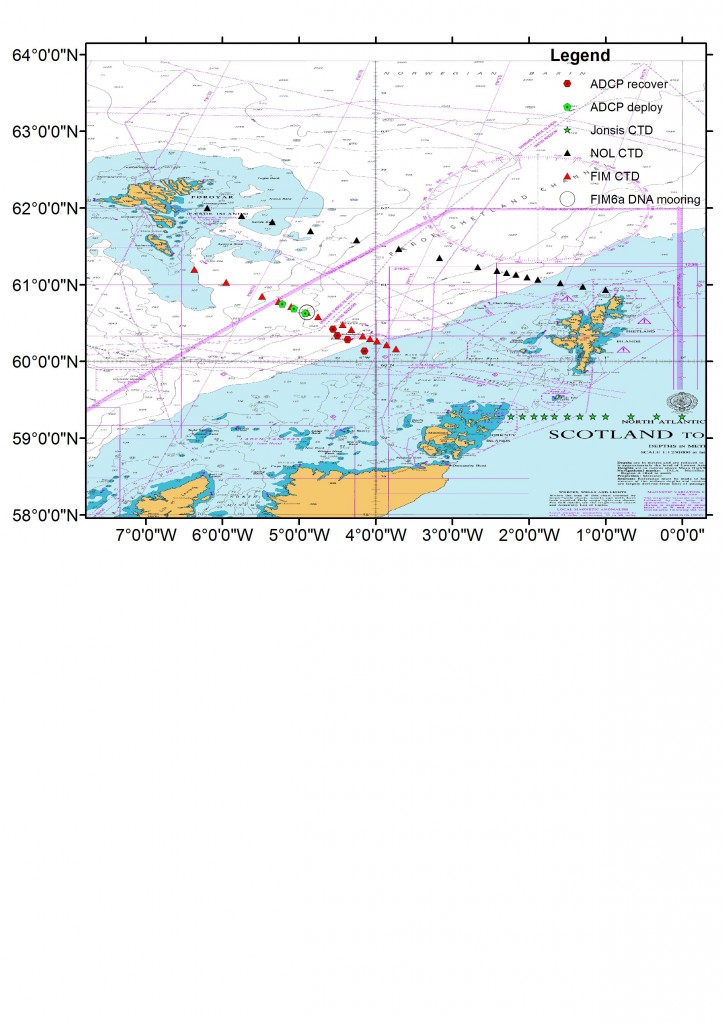Marine
MRV Scotia: Survey 0515S Programme
May 1, 2015 by Marine Directorate Communications No Comments | Category Compliance, Marine Directorate general, Marine Directorate Science, Research Vessel Surveys
Duration: 25 April – 8 May 2015
Gear:
Sea-Bird CTDs, ADCPs and current meter instrumentation, temperature mini-loggers, water filtering equipment, fridge and freezer (UoA’s), centrifuge equipment (HWU), bacteria sampling equipment (HWU), sediment sampling equipment (UoA), mooring equipment, recovery trawl, glider, sediment grabs (Hammon and Day), and sediment corers (MSS and UoA).
Objectives:
- Test the CTD in the Buchan Deep off Peterhead.
- Perform hydrographic sampling along the JONSIS long term monitoring section in the northern North Sea.
- Perform CTD stations at the ADCP moorings on the cross shelf line adjacent to the Fair Isle – Munken section.
- Recover and download the data recovered from the four ADCP moorings deployed on the cross shelf section, adjacent to the Fair Isle – Munken section, during 2014.
- Deploy three ADCP moorings at positions on Fair Isle – Munken section.
- Deploy and recover the dialysis (DNA) mooring for Heriot-Watt University twice during the cruise at FIM 6a location. Ideally two x three day deployments. Take water samples at this location.
- Perform hydrographic sampling along the long term monitoring Faroe-Shetland Channel sections, Fair Isle – Munken and Nolso – Flugga.
- Take water samples for long term storage at Fair Isle – Munken section stations FIM-01 and FIM-06.
- Take water samples for bacteria analysis at FIM03, FIM08, NOL07, NOL08 and SEFOS (b/w NOL03 and NOL03a).
- Take sediment samples at or near a number of the Nolso – Flugga section stations.
- Take micro plastic water samples at a number of locations.
- Deploy SAMS glider for the BP oil spill exercise.
- Deploy drifters for the BP oil spill exercise (TBC).
- Perform a number of other hydrographic sections if time allows.
- Perform ship board ADCP survey if time allows.
Procedure:
On sailing from Aberdeen the MRV Scotia will make passage to the start of the JONSIS long term monitoring section to commence sampling with the CTD and carousel water sampler. On route test deployments of the CTD and carousel will take place, using the newly developed deployment procedures (10 m soak). On completion of the JONSIS section passage will be made to the start of the ADCP line across the shelf edge adjacent to the Fair Isle – Munken (FIM) section and the CTD will be deployed at each location. After the completion of all the CTD profiles, the ADCP moorings will be recovered.
The ADCP instrumentation data will be downloaded and instruments and moorings refurbished on route to new deployment positions on the FIM section. A CTD dip will be performed at the FIM 6a station in order to gain water samples for the DNA mooring. On completion, Scotia will make her way to the westernmost ADCP deployment location. Three ADCPs will be deployed at the new deep mooring locations, and a CTD profile will be carried out at each mooring position once the mooring has been deployed. On completion of the ADCP moorings, the DNA mooring will be deployed at the FIM 6a station. Scotia will then make her way to the start of the FIM section for the long term monitoring samples and CTD profiles to be taken. After the FIM section, Scotia will return to station FIM 6a for the turnaround of the DNA mooring, involving recovering the mooring, performing a CTD dip and re-deploying the mooring. Thereafter, Scotia will make way to the area on the Faroe-Cape Wrath section.
During CTD and water sampling of the Nolso-Flugga long term monitoring section, grab samples and water samples will be taken for University of Aberdeen and Heriot-Watt University visiting scientists. Micro plastic samples will be taken opportunistically through the survey. Upon completion of the Nolso-Flugga long term monitoring section the Glider will be deployed at a location within Scottish waters (Faroe Shetland Channel). Scotia will then proceed to the FIM6a station to recover the DNA mooring. Any remaining time will be spent carrying out CTD sampling the Cape Wrath – Faroe section, repeating the Fair Isle – Munken section, and performing ADCP surveys. It is intended to leave the glider deployed.



Leave a comment